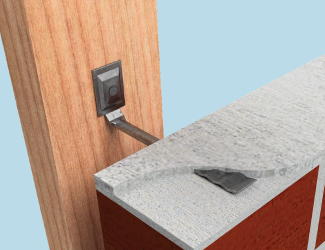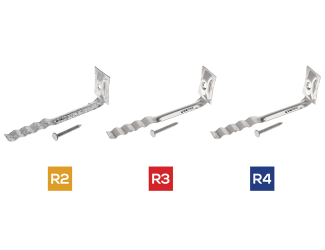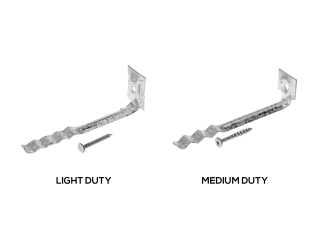AS 2699.1:2020 states that all wall ties (brick ties) are required to be tested and classified for durability and duty.
Durability classes:
R1, R2, R3, R4 and R5
Duty classes:
Light, Medium and Heavy Duty.


Durability classifications detail the type and mass of the coating material
Durability Classification of masonry wall ties manufactured from steel sheet, extracted from Table 3.1 of AS 2699.1:2020
| Durability Class | Material or protective coating specification |
|---|---|
| R1, R2 | Galvanised steel sheet to AS 1397 Z600 (minimum average coating thickness ≥ 42 μm) Galvanised after manufacture to AS/NZS 4680 HDG300 (minimum average coating thickness ≥ 42 μm) |
| R3 | Galvanised after manufacture to AS/NZS 4680 HDG470 (minimum average coating thickness ≥ 65 μm) Stainless steel grade ASTM A240 304 L |
| R4 | Stainless steel grade ASTM A240 316 L |
To conform to the requirements of this standard, VUETRADE supply wall ties in appropriate clearly marked packaging with easy access to further resources.

Duty classifies the mean strength rating of the wall tie
The Performance Criteria of AS2699.1 classifies Type A ties into light, medium or heavy duty classes.
The ties are classified in accordance with their mean strength as specified in the table below.
Type A veneer ties and Type A cavity ties mean strength (ft) extracted from Table 2.1 of AS 2699.1:2020
| Mean Strength | ||
|---|---|---|
| Duty Classification | Tension | Compression |
| Light Duty | 0.30 kN | 0.36 kN |
| Medium Duty | 0.60 kN | 0.72 kN |
| Heavy Duty | 1.50 kN | 1.80 kN |
To determine what strength classification of masonry tie is required (such as light duty or medium duty), will be depend on the site application of the ties.
A qualified architect or structural engineer must be consulted to determine which brick tie rating is required during building construction. This usually derives from specific load demands of the building site and also from the requirements listed in NCC 2022 Housing Provisions 5.6.5.

As a supplier of wall ties VUETRADE is required to provide clear information and, upon request, a copy of testing reports to prove each of the wall ties duty and durability classifications.
However it is up to the entity installing the wall tie to determine which wall tie durability and duty classifications are required for use in their project, in order to comply with the relevant building codes and Australian Standards.
National Construction Code 2022 – ABCB Housing Provisions
Table 5.6.5d from ABCB Housing Provisions of the NCC 2022 provides corrosion protection requirements for masonry wall ties in different exposure conditions along with recommended corrosion protections.
Table 5.6.5d Corrosion protection for wall ties
| Exposure condition | Tie specification (minimum corrosion protection) |
|---|---|
Areas less than 1km from breaking surf; or less than 100 m from salt water not subject to breaking surf; or within heavy industrial areas. | Grade 316L stainless steel; or engineered polymer complying with the requirements of AS 2699.1. |
Areas 1km or more but less than 10km from breaking surf; or 100m or more but less than 1km from salt water not subject to breaking surf. | Sheet steel and bar ties galvanised after manufacture - 470 g/m2 on each side; or galvanised wire ties - 470 g/m2 coating mass; or Grade 304L stainless steel. |
All other areas | Galvanised sheet steel - 300 g/m2 coating on each side; or sheet steel ties galvanised after manufacture - 300 g/m2 on each side. |
© Commonwealth of Australia and the States and Territories 2022, published by the Australian Building Codes Board.
SELECTION OF SUITABLE CORROSION PROTECTION ON VUETRADE PRODUCTS
VUETRADE offers products designed for use specifically in each exposure condition with adequate corrosion protection as per the requirement. These are categorised into three main categories:
STANDARD / GALVANISED - Internal / enclosed - Exterior/exposed inland areas except if in contact with fresh water or non-saline wetting & drying |
|
MARINE ENVIRONMENT – SS304 - Marine Environment - 100m up to 1km from a non-surf coast and from 1km up to 10km from a surf coast - External applications in contact with freshwater or subject to non-saline wetting and drying - Minimum steel grade required Stainless Steel 304 |
|
SEVERE MARINE – SS316 - Severe Marine - 100m from a non-surf coast and up to 1km from a surf coast - Minimum Steel Grade Stainless Steel 316 - No ‘Tea Staining’, a superficial ‘rust’ look that occurs on lower grades of Stainless Steel including 304. |
Using the chart provided, the necessary level of corrosion protection can be easily identified. It is highly recommended to adhere and comply to the minimum requirement of corrosion protection as failure to do so may lead to severe corrosion that will critically alter the structural integrity of a building.
Corrosion protection usage outside of what has been recommended in this guideline should be consulted and confirmed by the site engineer/structural engineer to ensure building compliance.
These classifications are based on AS2699.1:2020.
Technical Data, Design Capacities and Installation Guides are conveniently located on each Product Page on the VUETRADE website.
But did you know that they can also be found within the Compliance Guide which is available for ready download as a PDF, or as an A5 booklet at your local VUETRADE supplier?
VUETRADE Brick Tie Durability Classification and Duty Classification Guide
Brick Ties Specification Guide from VUETRADE follows the requirement from AS/NZS 2699.1:2000, in regards to the durability classification test.
Either view the specification guide here, or download the PDF version below:
PDF VUETRADE Timber Connectors Specification Guide – Brick Ties
As per requirement from AS/NZS 2699.1:2000, all wall ties are required to be tested and classified in terms of durability classification of R0, R1, R2, R3, R4 and R5. These durability classifications detail the type of coating material and its coating mass that is required in the manufacturing of wall ties as per Table 3 of AS/NZS2699.1:2000.
The table below shows the extraction of AS/NZS2699.1:2000 – Table 3 for durability classification of masonry wall ties.
[table “” not found /]VUETRADE Brick Veneer ties are manufactured in Z600 Galvanised Steel to suit Durability Classification R2, Stainless Steel 304 for Durability Classification R3 and Stainless Steel 316 for Durability Classification R4. AS/NZS2699.1:2000 states that this durability classification R0 to R5 are based on the aerosol penetration as per clause 2.4.4 (f) as follows,
[table “” not found /]The application of different brick ties based on durability classification are dependent on the location where the brick tie will be used. Reference can be made to Figure 1 which illustrates the location of brick tie applications and its minimum recommended brick tie material; and Table 2 describes the list of VUETRADE brick ties range along with its respective durability classification.

Duty Classification Guide
Apart from the durability classification, AS/NZS2699.1:2000 also requires supplier/distributor/manufacturer to run tests based on methodology listed in the standard’s Appendices A to H in order to qualify a product to be ‘compliant’. Appendix B in particular is necessary as a requirement to classify Type A ties (not required to have specific seismic design characteristic) into light, medium or heavy duty ties. From the standards, the classification of these ties are determined by the minimum characteristic strength of ties in tension and compression, listed in Table 1 of AS/NZS2699.1:2000. VUETRADE Brick Ties has verified test results on brick ties that classified brick ties into its light duty and medium duty classification depending on the return characteristic strength.
[table “” not found /]To determine what ties duty builders would need to use i.e. light duty or medium duty, are dependent on site application of brick ties. Qualified architect, structural engineer or building surveyor would need to be consulted to determine which wall tie duty rating are necessary in the building construction which takes into account of various requirements such as wall tying requirements and relevant lateral bending capacity for the design of cavity walls. VUETRADE as the supplier of the VUETRADE brick ties are required to provide information of the brick tie duty classification and durability classification, but it is up to the application of brick tie during the wall and building integrity design to determine on what tie duty classification would be needed in order to comply to relevant building codes and Australian Standard.

